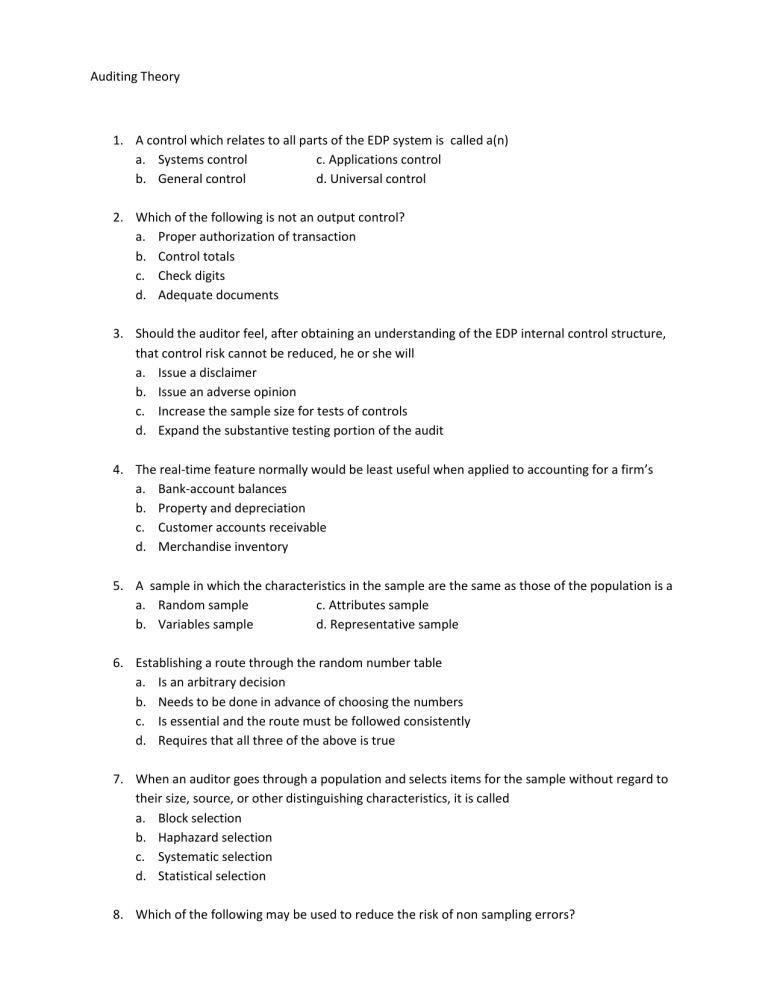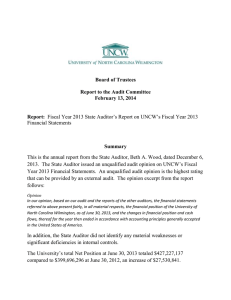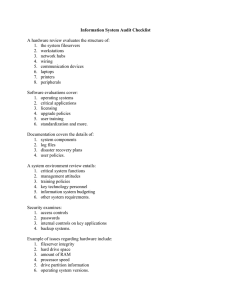
Auditing Theory 1. A control which relates to all parts of the EDP system is called a(n) a. Systems control c. Applications control b. General control d. Universal control 2. Which of the following is not an output control? a. Proper authorization of transaction b. Control totals c. Check digits d. Adequate documents 3. Should the auditor feel, after obtaining an understanding of the EDP internal control structure, that control risk cannot be reduced, he or she will a. Issue a disclaimer b. Issue an adverse opinion c. Increase the sample size for tests of controls d. Expand the substantive testing portion of the audit 4. The real-time feature normally would be least useful when applied to accounting for a firm’s a. Bank-account balances b. Property and depreciation c. Customer accounts receivable d. Merchandise inventory 5. A sample in which the characteristics in the sample are the same as those of the population is a a. Random sample c. Attributes sample b. Variables sample d. Representative sample 6. Establishing a route through the random number table a. Is an arbitrary decision b. Needs to be done in advance of choosing the numbers c. Is essential and the route must be followed consistently d. Requires that all three of the above is true 7. When an auditor goes through a population and selects items for the sample without regard to their size, source, or other distinguishing characteristics, it is called a. Block selection b. Haphazard selection c. Systematic selection d. Statistical selection 8. Which of the following may be used to reduce the risk of non sampling errors? a. b. c. d. Increasing the size of audit samples Stratifying audit samples Adequately planning audit samples Using statistical sampling techniques 9. A number of factors influences the sample size for a substantive test of details of an account balance. All other factors being equal, which of the following would lead to larger sample size? a. Greater reliance on internal control b. c. Smaller reliance o analytical procedures d. Smaller measures of tolerable misstatement 10. Fraudulent financial reporting is often called a. Management fraud c. Defalcation b. Theft of assets d. Employee fraud 11. The most important general ledger account included in and affecting several cycles is the a. General cash account c. Income tax expense ad liability accounts b. Inventory accounts d. Retained earnings account 12. In testing for cut-off , the objective is to determine a. Whether all of the current period’s transactions are recorded b. That no transactions from the prior period are included in the current period’s balances c. That no transactions of the curret period have been delayed and recorded in the future period. d. Whether transactions are recorded in the proper period. 13. The primary difference between an audit of the balance sheet and an audit of the income statement lies in the fact that the audit of the income statement deals with the verification of a. Transactions c. Costs b. Authorization d. Cutoffs 14. Documentation is a form of evidence a. Used in every financial statement audit b. Used in most financial statement audit c. Used o the rate occasions when it is both readily available ad less costly than other procedures d. Used when nothing is available that is more competent 15. The current file of the auditor’s working papers generally should include a. a flowchart of internal controls b. organization charts c. a copy of the financial statements d. copies of bond and note indentures 16. An audit working paper that reflects the major components of an amount reported in the financial statements is referred to as(an) a. Lead schedule c. Audit control schedule b. Supporting schedule d. Working trial balance 17. The major reason an independent auditor gathers audit evidence is to a. Form an opinion on the financial statements b. Detect fraud c. Evaluate management d. Evaluate internal control 18. An auditor most likely would analyze inventory turnover rates to obtain evidence concerning managements assertions about a. Existence or occurrence b. Rights and obligations c. Presentation and disclosure d. Valuation and allocation 19. To which type of the following matters would materiality limits not apply when obtaining client representations? a. Losses from sales commitments. b. Unasserted claims and assessments c. Irregularities involving management d. Noncompliance with contractual agreements 20. Which of the following procedures is more likely to be performed i a review engagement of a non-public entity that i n a compilation engagement? a. Gaining an understading of the entity’s business transactions b. Making a preliminary assessment of control risk c. Obtaining a representation letter from the chief executive officer d. Assisting the entity i adjusting the accounting records 21. In auditing accounts payable, an auditor’s procedures most likely would focus primarily o management’s assertion of a. Existence or occurrence b. Presentation and disclosure c. Completeness d. Valuation or allocation 22. Before goods are shipped on account, a properly authorized person must a. Prepare the sales invoice b. Approve the journal entry c. Approve credit d. Verify that the unit price is accurate 23. Which of the following is not a auditor’s concern about a key authorization point in the sales/collection cycle a. The receiving room must have authorization before releasing items to inventory control b. Credit must be authorized before sale c. Goods must be shipped after the authorization d. Prices must be authorized 24. Whenever footing ad comparisons are restricted to journals, master file records, and ledgers, the process is a. Valuation c. Cutoff b. Summarization d. Completeness 25. The most significant effect of the results of the tests of controls substantive tests of transactions in tha sales and collection cycle is on a. Allowance for uncollectible accounts b. Bad debts expense account c. Confirmation of accounts receivable d. Income tax payable 26. There is a difference between internal control objectives and audit objectives. Which of the following is not an audit objective? a. Validity c. Valuation b. Completeness d. Authorization 27. For effective internal control, employees maintaining the accounts receivable subsidiary ledger should not also approve a. Employee overtime wages b. Credit granted to customers c. Write-offs of customer accounts d. Cash disbursement 28. The general cash account is considered significant in almost all audits a. Where the ending balance’ is material b. Where either the beginning balance is material c. Even when the ending balance is immaterial d. Except those of not-for-profit organizations 29. Sales order form and invoice blanks should be controlled in the a. Sales order section of the sales department b. Billing clerk in the accounting department c. Credit manager in the credit department d. Sales manager in the sales department 30. Which of the following is a substantive test of transactions a. Review personnel policies b. Account for a sequence of payroll checks c. Reconcile the disbursements i the payroll journal with the disbursements on the payroll bank statement d. Examine printouts of transactions rejected by the computer as having invalid employee numbers 31. The information typically needed to prepare a production order would not include a a. Sales forecast c. Inventory plan b. Production plan d. Bill of materials 32. The substantive test which requires the auditor to “trace from a file of receiving reports to the acquisitions journal” satisfies the objective of a. Validity c. Completeness b. Authorization d. Valuation 33. An auditor usually examines receiving reports to support entries in the a. Voucher register and sales return journal b. Sales journal and sales return journal c. Voucher register and sales journal d. Check register and sales journal 34. The inventory and warehousing cycle can be thought of as comprising two separate but closely related systems, one involving the actual physical flow of goods, and the other the a. internal control over those goods b. related costs c. storing of the goods d. prevention of wastes, obsolenscence, and theft 35. In planning an audit engagement, which of the following is a factor that affects the independent auditor’s judgement as to the quantity, type, and content of working papers? a. The estimated occurrence rate of attributes b. The preliminary evaluation based upon initial substantive testing c. The content of the client’s representation letter d. The anticipated nature of the auditor’s report 36. A listing of all the things which the auditor will use to gather sufficient, competent evidence is the a. audit procedure b. audit plan c. audit program d. audit risk model 37. The primary emphasis in most tests of details of balances is on the a. balance sheet accounts b. income statement accounts c. cash flow statement accounts d. three statements above 38. Tracing recorded sales transactions in the sales journal to the shipping documents (bills of lading) provides evidence about the a. Completeness of recording of sales transactions b. Occurrence of sales transactions c. billing of all sales transactions d. presentation of payables 39. Which of the following is the best audit procedure for the detection of lapping? a. Comparison of postings of cash receipts to accounts with the details of cash deposits b. Confirmation of the cash balance c. Reconciliation of the cash account balances d. Preparing a proof of cash 40. To gather evidence regarding the balance per bank in the bank reconciliation, an auditor could examine all of the following except a. Cut-off bank statement b. year-end bank statement c. bank confirmation d. general ledger 41. The confirmation of accounts receivable is most closely associated with a. business risk b. detection risk c. inherent risk d. relative risk 42. The client’s physical count of inventories is lower than the inventory quantities in the perpetual records. This could be the result of a failure to record a. purchases b. purchases discounts c. sales d. sales discounts 43. The most likely technique for the current year audit of goodwill which was not acquired three years ago by a continuing audit client. a. Confirmation b. Observation c. Recomputation d. Inquiry 44. The auditor will most likely perform extensive tests for possible understatement of a. revenues b. assets c. liabilities d. capital 45. If the auditor is determined to lack independence, a disclaimer of opinion must be issued a. in all cases b. only if it is highly material c. only if it is material d. if the client requests it 46. The use of negative assurances in audit reports of historical financial statements is a. a violation of the standards of reporting b. encouraged by the Philippine Institute of CPAs c. a help in clarifying the degree of responsibility by being assumed by the auditor d. properly located in the opinion paragraph of the unqualified report 47. Unqualified financial statements for the prior year presented in comparative form with audited financial statements for the current year should be clearly marked to indicate their status and I. The report on the prior period should be reissued to accompany the current period report II. The report on the current period should include as a separate paragraph description of the responsibility assumed for the prior period’s financial statements a. b. c. d. I only II only Both I and II Either I or II 48. Compilation services are intended to enable a CPA firm to compete with a. Management advisory service firms b. Tax preparation businesses c. Computer service business d. Bookkeeping firms 49. A modification of the CPA’s report on a review of the interim financial statements of a publiclyheld company would be necessitated by which of the following? a. An uncertainty b. Lack of consistency c. Reference to another accountant d. Inadequate disclosure 50. Comfort letters ordinarily are signed by the client’s a. independent auditor b. underwriter of securities c. audit committee d. senior management ANSWER KEY 1) B 2) B 3) D 4) B 5) D 6) D 7) B 8) C 9) D 10) A 11) A 12) D 13) A 14) A 15) C 16) D 17) A 18) D 19) C 20) C 21) C 22) C 23) A 24) B 25) D 26) D 27) D 28) D 29) A 30) C 31) D 32) C 33) A 34) B 35) D 36) D 37) A 38) B 39) A 40) D 41) B 42) D 43) C 44) C 45) A 46) A 47) D 48) D 49) A 50) A



